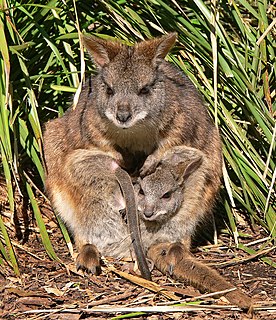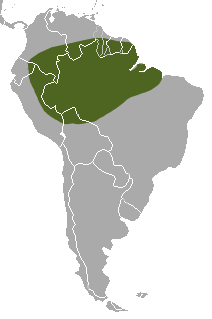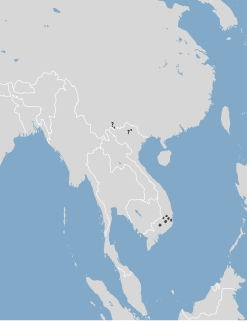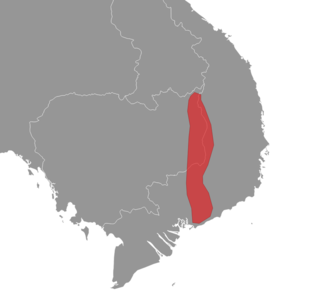
The parma wallaby is a small, hopping, kangaroo-like mammal native to forests of southeastern Australia. About the size of a stout cat, it lives in dense shrub and is only active at night to feed on grasses and small plants. It is the smallest of the wallabies and carries its young in a pouch like other marsupials. Shy and elusive, it was believed extinct until rediscovery in the 1960s. It is threatened by habitat loss and is easily killed by non-native foxes.

The family Talpidae includes the moles who are small insectivorous mammals of the order Eulipotyphla. Talpids are all digging animals to various degrees: moles are completely subterranean animals; shrew moles and shrew-like moles somewhat less so; and desmans, while basically aquatic, excavate dry sleeping chambers; whilst the quite unique star-nosed mole is equally adept in the water and underground. Talpids are found across the Northern Hemisphere of Eurasia and North America, and range as far south as the montane regions of tropical Southeast Asia.

The hairy-tailed mole, also known as Brewer's mole, is a medium-sized North American mole. It is the only member of the genus Parascalops. The species epithet breweri refers to Thomas Mayo Brewer, an American naturalist.

The Amazon weasel, also known as the tropical weasel, is a species of weasel native to South America. It was first identified from a museum specimen mislabelled as coming from Africa, hence the scientific name.
Podokesaurus is a genus of coelophysoid dinosaur that lived in what is now the eastern United States during the Early Jurassic Period. The first fossil was discovered by the geologist Mignon Talbot near Mount Holyoke, Massachusetts, in 1910. The specimen was fragmentary, preserving much of the body, limbs, and tail. In 1911, Talbot described and named the new genus and species Podokesaurus holyokensis based on it. The full name can be translated as "swift-footed lizard of Holyoke". This discovery made Talbot the first woman to find and describe a non-bird dinosaur. The holotype fossil was recognized as significant and was studied by other researchers, but was lost when the building it was kept in burned down in 1917; no unequivocal Podokesaurus specimens have since been discovered. It was made state dinosaur of Massachusetts in 2022.

The tailed tailless bat is a species of leaf-nosed bat from South America.

Euroscaptor is a genus of mammal in the family Talpidae. Members are found in China and South & Southeast Asia. It contains the following species as of October 2021:

The long-nosed mole is a species of mammal in the family Talpidae. It is endemic to China, where it has a widespread distribution.

The Himalayan mole or short-tailed mole is a species of mammal in the family Talpidae.

The Japanese mountain mole is a species of Old World mole in the family Talpidae. It is endemic to Japan. It is the only member of the monotypic genus Oreoscaptor. Its natural habitats are temperate forests and temperate grassland.

The small-toothed mole is a species of mammal in the family Talpidae. It is found in Di Linh, in southern Vietnam, and Rakho near the border of Vietnam and China, and in southern Yunnan, China, near the Vietnamese border. It is likely that it has a broader distribution, especially in places between the currently known locations.

Talpini is a tribe of mammals known as Old World Moles. It is a division of the subfamily Talpinae.

The Indochinese short-tailed shrew is a species of mammal of the family Soricidae found in China and Vietnam. The species is a semifossorial red-toothed shrew with a stout body and short, slender tail. Blarinella is distinguished from all other Southeast Asian shrew genera by their long claws, intensive colored red-tipped teeth, and five upper unicuspids. Although this species is classified under Blarinella, recent Cytochrome b analysis suggests this species should be classified under a new genus.

The Tonkin snub-nosed monkey or Dollman's snub-nosed monkey is a slender-bodied arboreal Old World monkey, endemic to northern Vietnam. It has black and white fur, a pink nose and lips, and blue patches around the eyes. It is found at elevations from 200 to 1,200 m on fragmentary patches of forest on craggy limestone areas. First described in 1912, the monkey was rediscovered in 1990 but is exceedingly rare. In 2008, fewer than 250 individuals were thought to exist, and the species was the subject of intense conservation effort. The main threats faced by these monkeys are habitat loss and hunting, and the International Union for Conservation of Nature has rated the species as "critically endangered".

Crocidura phanluongi is a species of shrew in the genus Crocidura from southern Vietnam and nearby Cambodia. It is a somewhat small, gray shrew with an ecologically diverse distribution.

The Indochinese shrew is a species of white-toothed shrew native to Southeast Asia. It was first identified in 1922 by Herbert C. Robinson and C. Boden Kloss. The species is often taxonomized as a subspecies Horsfield's shrew, but bears a different range, occurring in Myanmar, Vietnam, and the Yunnan province of China. C. indochinensis is on the smaller end of shrews, with dark brownish gray fur and a long, slender tail.
Kuznetsov's mole is a species of mammal in the family Talpidae. It is found in northern Vietnam and southern China. It was named after Russian mammalogist German V. Kuznetsov of the Russian Academy of Sciences.

Orlov's mole is a species of mammal in the family Talpidae. It is known from northern Vietnam, southern China, and possibly Laos. It was named after Russian zoologist Nikolai L. Orlov of the Russian Academy of Sciences.

The Ngoc Linh mole is a species of mammal in the family Talpidae. It is endemic to central Vietnam. It was named after Ngọc Linh mountain, which it was first discovered in the vicinity of.


















